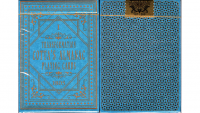Gilded Cotta's Almanac #1
PlayingCardDecks.com

Introducing a precisely digitally hand-recreated reproduction of the first published complete transformation playing card deck in the world! The blue "Joan of Arc" deck is the first in a series of six famous decks we plan to release.
The very first transformation deck issued by Cotta is from 1805. This deck is probably the most famous of all six, and is incredibly scarce. Original illustrations were fiddling artworks done by hand, on copper plates that were manually engraved with stipple and etching, and the cards were printed on linen period stock that was 97 mm x 69 mm in size, with blank card backs and squared corners at that time. Only the court cards were hand-colored, while the number cards used red stencils.
Cotta's transformation cards were very successful and became a role model for later transformation decks from other publishers. And since the card backs were blank, individual cards were sometimes used by the nobility as visit cards and for leaving messages, so these playing cards often became multi-purpose items.
The images on the court cards are characters inspired by Schiller's play "Die Jungfrau von Orleans" ("Joan of Arc").
The central figure of Joan of Arc is depicted as the Queen of Spades, the Maid of Orleans who inspired the French army to victory, but was later burned at the stake.
The court cards were designated with the words "Valet", "Dame", and "Roi", which are the French terms corresponding to the Jack, Queen, and King.
In the first deck, beside Joan of Arc depicted as the Queen of Spades, other individuals closely associated with Joan include Etienne de Vignolles or La Hire (Jack of Hearts), who helped Joan to victory in the battle of Patay in 1429; and Raymond (Jack of Diamonds), a peasant who was Joan's page.
Key political leaders who figured prominently in the events surrounding Joan's life are also represented, including King Charles VII (King of Hearts), the French monarch who relied on Joan's help to reach the Rhiems, the traditional place of coronation; Charles' mother Isabeau (Queen of Hearts), who was in league with Charles' enemy; Charles' mistress Agnes Sorel (Queen of Diamonds); Charles' opponent Philippe the Good (King of Diamonds), an ally of England; and the king of Naples, Ren






